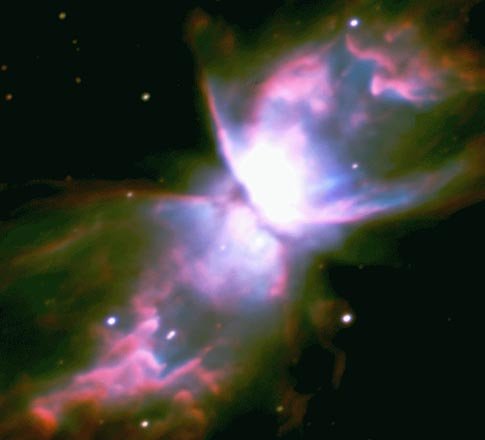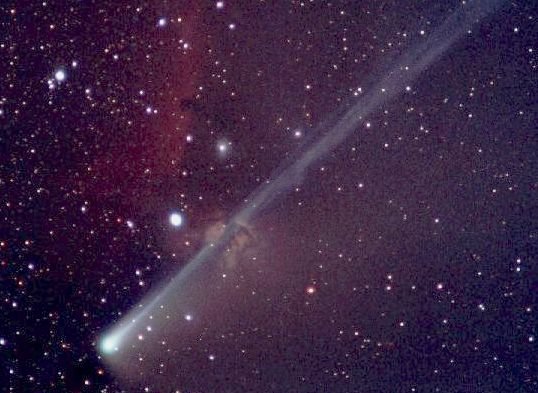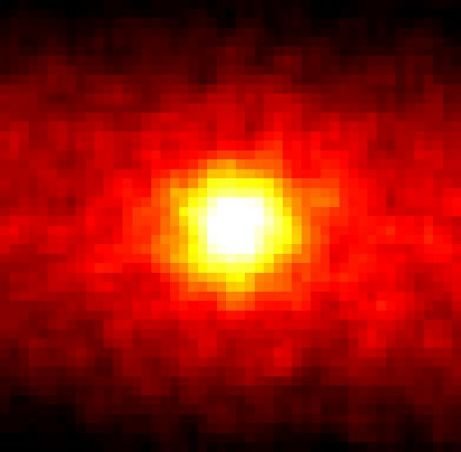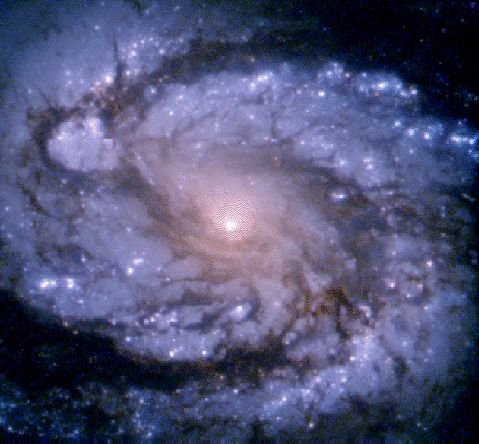NASA APOD #1078-1085
#1078 Solar Flares Cause Sun Quakes June 01, 1998
“An 11th magnitude quake has been recorded on the Sun, immediately following a moderate solar flare. The quake was the first ever recorded on the Sun, but only because astronomers have only recently figured out when and how to find them using the orbiting SOHO spacecraft. Dark waves from the quake can be seen in the above picture spreading out from an explosive bright flare. The solar ripples are similar in appearance to waves caused by a rock thrown into a pond. The magnitude and evolution of these quakes gives information about the physical nature of solar flares, the surface of the Sun, and even the Sun's interior."
Copyright: Public domain
#1079 NGC 6302: The Butterfly Nebula June 02, 1998
“The Butterfly Nebula is only thousands of years old. As a central star of a binary system aged, it threw off its outer envelopes of gas in a strong stellar wind. The remaining stellar core is so hot it ionizes the previously ejected gas, causing it to glow. The different colors of this planetary nebula are determined by small differences in its composition. This bipolar nebula will continue to shine brightly for only a few thousand more years, after which its central star will fade and become a white dwarf star. The above picture is one of the first ever taken by the Very Large Telescope (VLT), a new 8.2-meter telescope located in Chile."
Copyright: Very Large TelescopeESO
#1080 Martian Crater Shows Evidence of Dried Pond June 03, 1998
“Did a pond once exist in this Martian crater? Recent photographs by the spacecraft Mars Global Surveyor, currently in orbit around Mars, show features unusual for Mars yet similar to a dried pond on Earth. Previously, much evidence suggested the effects of ancient channels of flowing water on Mars, but less evidence had been found for dried pools of water. Islands and bays on this crater floor indicate an accumulation of some liquid, however, a hypothesis consistent with channels found on the (inset) crater walls. As it is also possible the features were formed by other mechanisms including flowing lava, future observations and analysis will be needed to say for sure."
Copyright: Public domain
#1081 Comet SOHO and Nebulae in Orion June 04, 1998
“Astrophotographer Michael Horn captured this gorgeous view of comet SOHO in the dark night sky above Wandibindle, Queensland, Australia on May 23rd. On this date, comet SOHO was moving against the background of the nebula-rich constellation of Orion. South is up in the picture which shows SOHO's bright head or coma and long tail extending past the glowing gas clouds and dark dust lanes of the Flame and Horsehead nebulae. Alnitak, the bright star above and to the right of the cometary coma, is also known as Zeta Orionis, the eastern-most of the three stars in Orion's belt. Southern Hemisphere observers report that comet SOHO has recently undergone a dramatic increase in brightness."
Copyright: M. Horn
#1082 Neutrinos in the Sun June 05, 1998
“Neutrinos, along with things like electrons and quarks, are fundamental pieces of matter according to physicists' Standard Model. But neutrinos are hard to detect. Readily produced in nuclear reactions and particle collisions, they can easily pass completely through planet Earth without once interacting with any other particle. Constructed in an unused mine in Japan, an ambitious large-scale experiment designed to detect and study neutrinos is known as Super-Kamiokande or "Super-K". Only(!) 500 days worth of data was needed to produce this "neutrino image" of the Sun, using Super-K to detect the neutrinos from nuclear fusion in the solar interior. Centered on the Sun's postion, the picture covers a significant fraction of the sky (90x90 degrees in R.A. and Dec.). Brighter colors represent a larger flux of neutrinos. News: In a tantalizing recent announcement, an international collaboration of Super-K researchers has now presented evidence that the ghostly neutrinos undergo quantum mechanical oscillations, changing their particle identities and quantum properties over time. Theorists have considered neutrinos to be massless particles but these oscillations would imply that they have a very small (but nonzero) mass. Astrophysicists are taking note because even a small mass for ubiquitous, nearly undetectable neutrinos would make them accountable for a substantial fraction of the total mass of our Universe, influencing and perhaps determining its ultimate fate! A measurable mass for neutrinos would also make them candidates for the mysterious dark matter known to affect the motions of stars and galaxies, while proof of neutrino oscillations would be a step toward resolving the decades old Solar Neutrino Problem. Even skeptical scientists will be waiting impatiently to see if these results are independently confirmed."
Copyright: Public domain
#1083 M100: A Grand Design June 06, 1998
“Majestic on a truly cosmic scale, M100 is appropriately known as a Grand Design spiral galaxy. A large galaxy of over 100 billion or so stars with well defined spiral arms, it is similar to our own Milky Way. One of the brightest members of the Virgo Cluster of galaxies , M100 (alias NGC 4321) is 56 million light-years distant in the spring constellation of Coma Berenices. This Hubble Space Telescope image of the central region of M100 was made in 1993 with the Wide Field and Planetary Camera 2. It reveals the bright blue star clusters and intricate winding dust lanes which are hallmarks of this class of galaxies. Studies of stars in M100 have recently played an important role in determining the size and age of the Universe."
Copyright: Public domain
#1084 The Hubble Deep Field June 07, 1998
“Galaxies like colorful pieces of candy fill the Hubble Deep Field - humanity's most distant yet optical view of the Universe. The dimmest, some as faint as 30th magnitude (about four billion times fainter than stars visible to the unaided eye), are the most distant galaxies and represent what the Universe looked like in the extreme past, perhaps less than one billion years after the Big Bang. To make the Deep Field image, astronomers selected an uncluttered area of the sky in the constellation Ursa Major (the Big Bear) and pointed the Hubble Space Telescope at a single spot for 10 days accumulating and combining many separate exposures. With each additional exposure, fainter objects were revealed. The final result can be used to explore the mysteries of galaxy evolution and the infant Universe."
Copyright: Public domain
#1085 A Mars Glint June 08, 1998
“Tomorrow's picture: Ice Cusps on Europa < Archive | Index | Search | Calendar | Glossary | Education | About APOD > Authors & editors: Robert Nemiroff (MTU) & Jerry Bonnell (USRA) NASA Technical Rep.: Jay Norris. Specific rights apply. A service of: LHEA at NASA/ GSFC &: Michigan Tech. U."
Copyright: Public domain
Upvote! Resteem! Comment! As you like it! Thank you for attention!








Good day STEEMIAN!
This is all free and opensource information; all you need to do is upvote all posts of @lightingmacsteem and @minnowminer and receive the sharing of the 33 percent of all SBD author rewards on a daily basis, no questions asked.
The @minnowminer program aims to help in the awareness program of the versatile JOULESTEEM circuit, a non-solar non-wind approach to low-power offgrid energy generation by re-distributing and sharing the daily SBD gains of all posts made by @lightingmacsteem and @minnowminer.
The JOULESTEEM circuit is reaching a very encouraging milestone (@lightingmacsteem post #51) that enables it to harness non-conventional offgrid power sources (air and ground as a huge capacitor) which is in turn made to charge big capacity batteries. This makes it very much ideal for low-power energy generation no matter the location, no matter the weather, no matter what time of the day.
To be able to fast-track its adoption worldwide and to where it may be needed most, the @minnowminer program is introduced to encourage all STEEMIANS to help and be part of the quick transformation of the JOULESTEEM circuit.
This is maybe the only straight-to-the-point no-questions-asked sharing scheme that will enable each one to earn and learn as a STEEMIAN.
Keep on STEEMING guys!!!